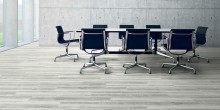
When selecting affordable flooring in New Zealand, many options are available to cater to your preferences and practical needs.
In New Zealand, two contenders have risen to the forefront—Vinyl and Laminate.
This blog post will guide you in deciphering the differences between these two flooring options, allowing you to make an informed decision that aligns with your preferences and needs.
LIFESPAN
Both vinyl and laminate flooring offer longevity spanning 5 to 25 years, depending on material quality, installation quality and usage frequency. However, the actual lifespan of each type of flooring can vary significantly based on various factors, including wear layer thicknesses and environmental conditions such as temperature fluctuations and sunlight exposure.
COST
Whether you're looking to renovate your home in the vibrant city of Auckland or elsewhere in New Zealand, vinyl and laminate can be attractive options for those aiming to achieve a visually appealing and durable flooring solution without breaking the bank.
Regarding flooring options, vinyl and laminate are cost-effective alternatives, particularly compared to traditional choices like wood, stone, or carpet. Both options fall within a similar price range, making them ideal for projects New Zealand-wide. This balance between cost-efficiency and aesthetics makes vinyl and laminate flooring particularly appealing to budget-conscious homeowners and property developers.
MATERIAL COMPOSITION
Vinyl Flooring
Often mistaken for a homogeneous material, vinyl flooring is, in reality, a multi-layered product primarily consisting of layers of PVC (polyvinyl chloride) and other additives. It usually consists of four layers that play distinct roles. The top layer is a transparent wear layer, followed by a high-definition photographic layer. Beneath these, a thick core layer forms the bulk of the flooring, then a durable bottom layer. This composition gives vinyl flexibility, durability, and water resistance, making it suitable for various settings, including kitchens and bathrooms.
Laminate Flooring
Laminate flooring is composed of multiple layers, too, with a core of high-density fibreboard (HDF) sandwiched between a printed design layer and a protective wear layer. Although not as waterproof as vinyl, laminate flooring can still handle moderately wet environments when properly maintained. However, water is the enemy of wood, so there are usually limitations, especially so with cheaper-grade laminate options.
APPEARANCE AND DESIGN AESTHETICS
Vinyl Flooring
The most remarkable aspect of vinyl flooring lies in its extensive range of designs and aesthetics, which are not typically available with laminate flooring. Vinyl flooring encompasses various colours and variations that mimic natural timber, stone, polished concrete, mosaic, retro, and tile flooring patterns. The diversity is truly abundant, from hand-scraped and rustic styles to reclaimed wood and multi-tonal designs, as well as options like natural finishes, whitewashed effects, and multi-length planks. Advanced printing technology allows vinyl to mimic natural materials' look while maintaining its unique benefits.
Laminate Flooring
Laminate flooring typically emulates hardwoods, softwoods, and stained timber in plank form. The photographic layer in laminate flooring replicates intricate details, providing an aesthetic appeal that suits various interior styles.
DURABILITY AND MAINTENANCE
Vinyl Flooring
Vinyl flooring's robustness shines in high-traffic areas as it is resistant to scratches, dents, and stains. Its water-resistant nature prevents warping and damage from spills, making it particularly apt for homes with children or pets. Maintenance involves routine sweeping and occasional damp mopping. Vinyl flooring can be wet-mopped, while this can cause problems with laminate flooring.
Laminate Flooring
Laminate flooring's HDF core lends its strength against impact, but it tends to be more susceptible to scratching compared to vinyl. Cleaning laminate requires regular sweeping, occasional damp mopping, and avoiding excessive moisture.
INSTALLATION EASE
Vinyl Flooring
Vinyl flooring is easy to install. Vinyl flooring may be glued or loose-laid to subflooring surfaces, but some planks and tiles feature a tongue-and-groove feature that allows for faster installation directly over the subfloor. Adhered vinyl flooring is available in sheet or tile or plank formats. On the other hand, floating vinyl flooring, known as loose-lay vinyl or Hybrid Planking, involves sheets with a specially formatted loose-lay backing and/or planks that interlock but remain detached from the subfloor. Another advantage is that, in some cases, vinyl flooring can be installed directly over existing floors, reducing the need for extensive subfloor preparation.
Laminate Flooring
All laminate floors are floating floors. Laminate flooring uses a tongue-and-groove locking system, making it a popular choice for DIY enthusiasts. However, precise installation and careful preparation is crucial to prevent gaps and ensure longevity. Sometimes, an underlay is required for laminate flooring, adding to the installation cost.
WATER, HEAT, AND ENVIRONMENTAL RESILIENCE
Vinyl Flooring
Regarding water resistance and heat tolerance, vinyl flooring proves its worth. The top-to-bottom composition of vinyl flooring is waterproof, but only partially because water can still enter transitions, joints and perimeters. While heat can impact vinyl flooring, it's worth noting that the heat specifications adhered to by most vinyl floorings typically surpass the levels encountered during regular usage.
Laminate Flooring
The susceptibility of laminate flooring to water is influenced by its wood-based core. Pooled water near seams or edges can seep into the core, expanding and damaging the internal composition. Even after drying, the core might not revert to its initial dimensions, highlighting the importance of guarding against water exposure.
Laminate flooring's high-density fiberboard core is generally resistant to heat. However, extreme heat can impact other layers, such as the top wear layer, possibly causing melting or discolouration.
Conclusion
Both vinyl and laminate flooring possess distinctive qualities that can cater to various lifestyles and preferences. While vinyl flooring impresses with its water resistance and durability, your choice between vinyl and laminate should align with your specific needs, design aspirations, and environmental considerations.
At KR Flooring, we're committed to helping you make the best decision for your space, ensuring a seamless flooring solution blends aesthetics and functionality.
READY TO TRANSFORM YOUR SPACE WITH DIVERSE VINYL FLOORING?
EXPLORE KR FLOORING'S SUPPLIES AND INSTALLS AN EXQUISITE RANGE OF VINYL AND DISCOVER THE PERFECT BLEND OF STYLE AND DURABILITY FOR YOUR HOME OR OFFICE.
SEARCH NOW

 Filtered search
Filtered search






